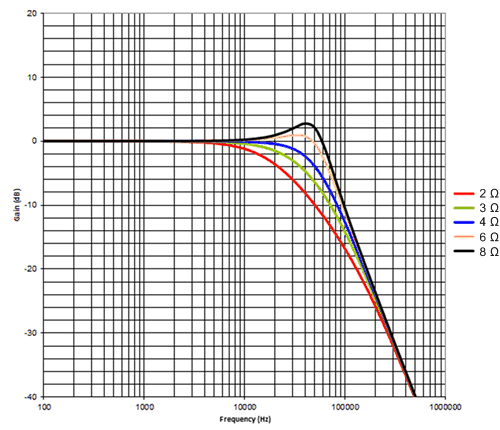SLAU874 October 2022 TPA3223
-
TPA3223 Evaluation Module
- Trademarks
- 1.1 Quick Start (BTL MODE)
- 1.2 Setup By Mode
- 1.3 Hardware Configuration
- 1.4 EVM Design Documents
- Trademarks
- 1Quick Start (BTL MODE)
- 2Setup By Mode
- 3Hardware Configuration
- 4EVM Design Documents
1.5.13 LC Response and Overview
Included near the output of the TPA3223 device are four output LC filters. These output filters filter the PWM output leaving only the audio content at high power which is fed to the speakers. The board uses a Sagami 10-µH inductor and 1-µF film capacitor to form this LC filter. Using the equations listed in LC Filter Design (SLAA701), the filter low pass cut-off is as follows:

The frequency response of the filter per output load is illustrated in Figure 3-15.
 Figure 3-15 Filter Frequency
Response
Figure 3-15 Filter Frequency
ResponseFigure 3-15 is taken directly from the LC Filter Calculator tool available on TI.com (SLAC729). The tool is configured for BTL common mode with values of 10 µH and 1 µF for the filter. This tool is also helpful when designing a different board featuring one of TI’s class-D amplifiers.
The Sagami inductor used (7G14D-100M-R) has a saturation current of 15 A. This was selected for the EVM since the TPA3223 supports a maximum short-circuit output current of 9 A. The inductance versus current curve for a selected inductor is very important. It is essential for the inductor to maintain at least 5 µH of inductance at the maximum short-circuit current of the power amplifier. The Sagami inductance versus current curve is available in the 7G14D-100M-R data sheet on the Sagami web site.
Although not required, shielded inductors are used on the EVM to reduce EMI.